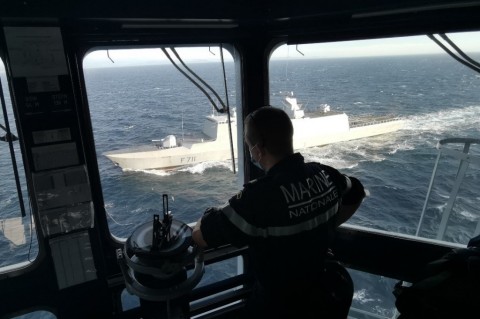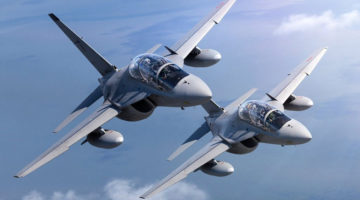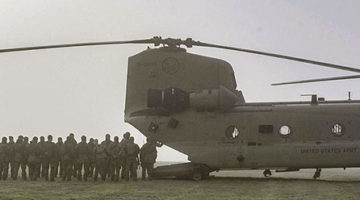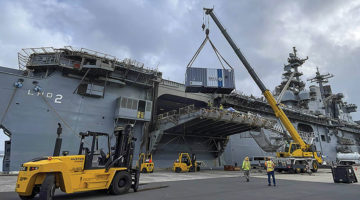By Murielle Delaporte – This is the second part of a long version of an article published in the US publication Breaking Defense on March 11th, 2021.
Enhancing Joint Indopac Power Projection
Protecting the sovereignty of its territories and the growing number of French citizens leaving in them always required an adequate military force composed of forward-based assets and troops. These ‘’prepositioned’’ forces are called ‘’presence forces’ and include 7 to 8,000 permanent troops, as well as 700 temporary deployed personnel. They are organized under five commands, three sovereign – in the Indian Ocean in Reunion and Mayotte (FAZSOI) and in the South Pacific in New Caledonia (FANC) and French Polynesia (FAPF) – and two in foreign countries – Djibouti (FFDj) and the United Arab Emirates (FFEAU) – for a ‘’permanent deployment in the Northern Indian Ocean’’, as described by the French Ministry of the Armed Forces. It is from the latter that the French armed forces participate to Allied operation Inherent Resolve against Daesh, and, before that, to Operation Enduring Freedom in Afghanistan (till 2012).
Very much like most NATO forces, the overseas sovereign forces were rather neglected in the name of the Peace dividends and a false sense of security. Although ‘’absolutely crucial to defend sovereign interests and participate to ad hoc coalitions’’, as pointed out by the above-quoted French naval officer, it is only in the past few years that they started to be modernized and built back close to their 2008 level, while power projection from the mainland has become increasingly visible and inclusive with more and more allies beyond the traditional four, i.e., the United States, India, Australia and Japan.
‘’ As a maritime, air and spatial power, France possesses high level intelligence gathering means and significant force projection platforms. France is therefore able to contribute to each aspect of international security with its allies and partners.
France organizes regular multilateral exercises in the Indian Ocean (Papangue) and in the Pacific (Equateur, Croix du Sud, Marara). These exercises can gather up to several thousand military personnel coming from a dozen partner States.
France participates to many multilateral military exercises in Southeast Asia (Cobra Gold, Komodo, Pitch Black, Tempest Express, Coores, Marixs), in Northeast Asia (Khaan Quest, Ulchi Freedom Guardian, Key Resolve) and in the Pacific (Rimpac, Southern Katipo, Tafakula, Americal, Kakadu, Pacific Partnership). These exercises aim to increase mutual understanding and to create bonds between the different armed forces.
Many bilateral exercises are also organised at each French Navy and Air Force assets visits in the region. The regular high-level bilateral exercises Shakti (Army), Varuna (Navy) and Garuda (Air Force) embody the strategic partnership bonding France and India”, summarizes the 2019 “France and Security in the Indo-Pacific” official report.
In addition to the regular exercises traditionally organized in the Indian Ocean, such as the above-mentionned Varuna with India since 1993, as well as in the Pacific, such as the biannual ‘’Croix du Sud’’ humanitarian and relief exercise held from New Caledonia, what is interesting to highlight is the recent ability of the French armed forces to project faster and further both at sea and in the air from the continent. Strategic depth has become the name of the game for French military planners and the technology makes it possible today in unprecedented ways.
The acquisition of the A330 multirole Tanker Transport (MRTT) Phenix as well as of the A400M has for instance been a gamechanger for the French Air and Space Force which can now conduct long-range and in-depth raids. The MRTT is an asset particularly important for the airborne strategic nuclear forces which are the ones conducting these type missions. In 2018 the ‘’Pegase’’ mission occurred in the aftermath to the French participation to the Australian ‘’Pitch Black’’ exercise. Launching a new type of Air diplomacy able to be mixed and matched with the more traditional naval diplomacy, ‘’Pegase’’ gathered three Rafale fighters, one A400M, one C-135 FR tanker and one A310 and 120 aviators and included stops in Indonesia, Malaysia, Vietnam, Singapore and India.
From January 20th to February 5th, 2021, the French Air and Space Force conducted a long-range mission called Skyros which started in Djibouti to go to India, the United Arab Emirates, Egypt and Greece and involved four Rafale, one MRTT, one A400M and some 170 aviators. In June another power projection mission called ‘’Heiphara’’, is planned in the Indopacific deploying again170 personnel, with this time four Rafale, two MRTTs and one A400M straight to Tahiti and back via Norfolk to celebrate the 240th anniversary of the battle of Yorktown in the fall… As a French Air and Space Force officer stresses, ‘’these kinds of exercises allow to improve our interoperability: with a country like India which traditionally purchases a third of its military equipment from Russia, a third from Israel and a third from NATO countries, it is interesting for Rafale and Sukoi 30 to train as wingmen…’’
The same goes on the water where the French Navy conducts operations all the time, such as the current deployment of the Frigate ‘’Prairial’’ from Tahiti to monitor the embargo against North Korea in cooperation with Japan after a technical stop in Guam (a remake of the 2019 mission in that area).
The ‘’Marianne mission’’ which deployed during eight months and for the first time in the Western Pacific a nuclear attack submarine, SSN ‘’Emeraude’’, with a support ship, ‘’Seine’’, just ended and was aimed at enhancing cooperation with France’s main naval partners, Australia, the United States and Japan.
A few days ago, the yearly training mission ‘’Jeanne d’Arc’’ started and an Amphibious Ready Group (ARG) – including the PHA ‘’Tonnerre’’, the Frigate ‘’Surcouf’’, an amphibious task force armed with two ‘’Gazelle’’ helicopters – departed for a five month deployment period (instead of the usual four) through the Mediterranean, the Red Sea, the South China Sea, the Indian and Pacific Oceans. A mix of operational missions – counterterrorism, security, interoperability with NATO’s Combined task Force CFT 150, as well as humanitarian (with a Covid prism) – will be carried out, while conducting several bilateral exercises with some of the visited countries (Egypt twice, Djibouti, India, Indonesia, Vietnam, Japan twice, Singapore, Malaysia, Sri Lanka). An amphibious exercise is for instance planned with the US and Japan in the Senkaku Islands in May.
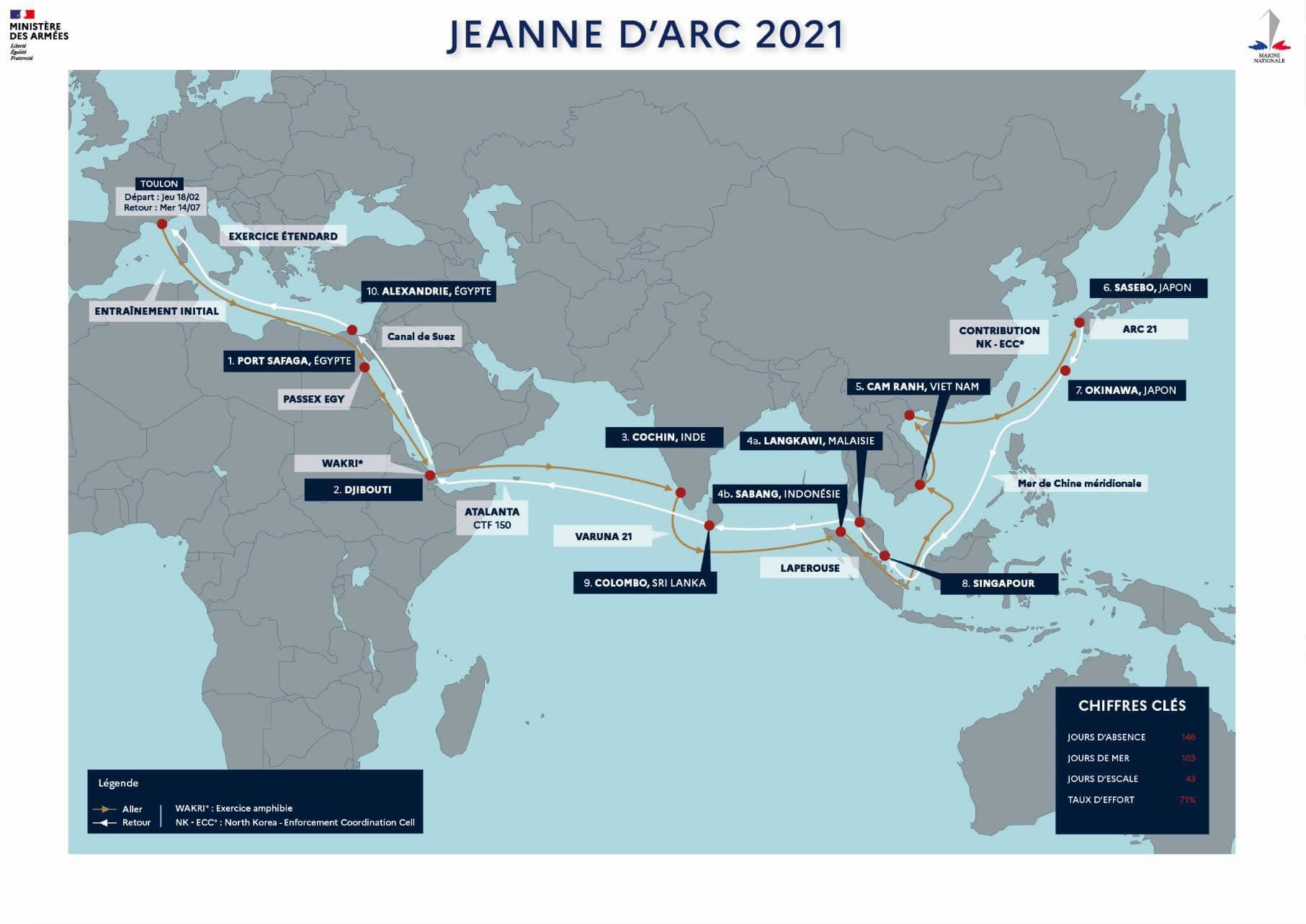 Photo © press kit Jeanne d’Arc Mission >>> Jeanne d’Arc Mission 2021
Photo © press kit Jeanne d’Arc Mission >>> Jeanne d’Arc Mission 2021
If the defense of French interests in the Indopacific region has been re-affirmed under the Macron presidency, it is done under the umbrella of the same desire to get other European nations to join forces all around the world – whether in Sahel or in the Levant region – in order to weigh more in front of abusive authoritarian powers and/or transnational violence, as well as in the counter-proliferation field given the coexistence of several nuclear powers in the Indopacific region. Besides the United Kingdom, another traditional Asia-Pacific power, but because of Brexit, France was for a while the only European nation to have a specifically laid-out Indopacific strategy. Not any more: Germany designed last September its own Indopacific strategic guidelines and will deploy a ship for a show of presence in what is considered today the world’s economic lung.
There has been increased concern about the rise of joint naval exercises carried by both China and Russia not only in the Western Pacific and South China Sea, but also in the Mediterranean, the Black Sea and the Baltics. Indeed, the Chinese entered the Baltic Sea for the first time during a Sino-Russian exercise called ‘’Joint Sea 2017’’. Two years later, “Joint Sea 2019” was the theater for the very first joint sea-based live-fire air defense exercise involving the Chinese People’s Liberation Army Navy (PLAN) and Russian Navy. And this month, Russia, China and Iran are conducting joint naval exercise in the northern Indian Ocean.
The French government’s observation that a dangerous ‘’contraction of the geopolitical space’’ is taking place due to globalization, the impact of climate change on the maritime roads (cf : Chinese goal to link the Baltic sea region to the polar silk region in the Arctic) and new great powers’ military assertiveness is rooted in such drastic evolutions.
A lot more than the eye can meet is therefore at stake and that is what Paris hopes to convey during its next European presidency during which a common European Union Indopacific strategy could be born adding a little extra-weight in a region striving for the right and perennial balance of power.
Photo © The Jeanne d’Arc Mission begins >>> www.colsbleus.fr









